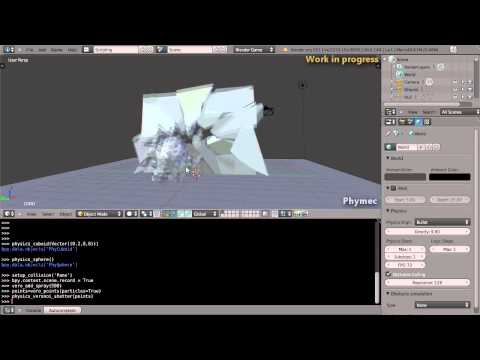Destructible Objects and Fracturing


Not exactly. I’m using cell fractured pieces from a cube but all randomly placed and chosen. They won’t fit to the same cube again, but they look like they do.
I did:
- annotation pen (on surface) in blender, scribbled around, then did a cell fracture of annotations to make a bunch of pieces out of it
- Alt + G set all selected pieces to origin
- Used a script to batch export all of them at once
- Batch renamed them to 1.fbx, 2.fbx, etc
- Used a simple bash script I made to batch convert to mdl with Asset Importer. This was easier because the filenames could be the ${i} in the script’s loop
- Simple loop to load all mdl’s to a table when I might need them
- On node collision (above a force threshold) I remove the cube, and insert an appropriate number of randomly chosen/placed pieces in its place
- Lastly, I apply a force that is both a little random and influenced by the impacting body
I think this is great because it’s always different and looks fairly real. For my purposes, the whole block can break on impact. I don’t need partial fractures or anything. What’s nice is I can easily add a ton more pieces without any tedious exporting, importing, or anything like that. I’m going to make a separate list of random tiny pieces and sprinkle those around the exact collision point to make a little extra fancy dust and realism.
Here’s the blender batch export script I’m using:
# ##### BEGIN GPL LICENSE BLOCK #####
#
# This program is free software; you can redistribute it and/or
# modify it under the terms of the GNU General Public License
# as published by the Free Software Foundation; either version 2
# of the License, or (at your option) any later version.
#
# This program is distributed in the hope that it will be useful,
# but WITHOUT ANY WARRANTY; without even the implied warranty of
# MERCHANTABILITY or FITNESS FOR A PARTICULAR PURPOSE. See the
# GNU General Public License for more details.
#
# You should have received a copy of the GNU General Public License
# along with this program; if not, write to the Free Software Foundation,
# Inc., 51 Franklin Street, Fifth Floor, Boston, MA 02110-1301, USA.
#
# ##### END GPL LICENSE BLOCK #####
# <pep8 compliant>
bl_info = {
"name": "Batch export FBX files",
"author": "brockmann",
"version": (0, 1, 0),
"blender": (2, 80, 0),
"location": "File > Import-Export",
"description": "Batch Export Objects in Selection to FBX",
"warning": "",
"wiki_url": "",
"tracker_url": "",
"category": "Import-Export"}
import bpy
import os
from bpy_extras.io_utils import ExportHelper
from bpy.props import (BoolProperty,
FloatProperty,
StringProperty,
EnumProperty,
CollectionProperty
)
class Batch_FBX_Export(bpy.types.Operator, ExportHelper):
"""Batch export objects to fbx files"""
bl_idname = "export_scene.batch_fbx"
bl_label = "Batch export FBX"
bl_options = {'PRESET', 'UNDO'}
# ExportHelper mixin class uses this
filename_ext = ".fbx"
filter_glob = StringProperty(
default="*.fbx",
options={'HIDDEN'},
)
# List of operator properties, the attributes will be assigned
# to the class instance from the operator setting before calling.
# context group
use_selection_setting: BoolProperty(
name="Selection Only",
description="Export selected objects only",
default=True,
)
use_mesh_modifiers_setting: BoolProperty(
name="Apply Modifiers",
description="Apply modifiers (preview resolution)",
default=True,
)
axis_forward_setting: EnumProperty(
name="Forward",
items=(('X', "X Forward", ""),
('Y', "Y Forward", ""),
('Z', "Z Forward", ""),
('-X', "-X Forward", ""),
('-Y', "-Y Forward", ""),
('-Z', "-Z Forward", ""),
),
default='-Z',
)
axis_up_setting: EnumProperty(
name="Up",
items=(('X', "X Up", ""),
('Y', "Y Up", ""),
('Z', "Z Up", ""),
('-X', "-X Up", ""),
('-Y', "-Y Up", ""),
('-Z', "-Z Up", ""),
),
default='Y',
)
global_scale_setting: FloatProperty(
name="Scale",
min=0.01, max=1000.0,
default=1.0,
)
def execute(self, context):
# get the folder
folder_path = os.path.dirname(self.filepath)
# get objects selected in the viewport
viewport_selection = context.selected_objects
# get export objects
obj_export_list = viewport_selection
if self.use_selection_setting == False:
obj_export_list = [i for i in context.scene.objects]
# deselect all objects
bpy.ops.object.select_all(action='DESELECT')
for item in obj_export_list:
item.select_set(True)
if item.type == 'MESH':
file_path = os.path.join(folder_path, "{}.fbx".format(item.name))
# FBX settings
bpy.ops.export_scene.fbx(
filepath=file_path,
use_selection=self.use_selection_setting,
use_active_collection=False,
global_scale=self.global_scale_setting,
apply_unit_scale=True,
apply_scale_options='FBX_SCALE_NONE',
bake_space_transform=False,
object_types={'EMPTY', 'CAMERA', 'LIGHT', 'ARMATURE', 'MESH', 'OTHER'},
use_mesh_modifiers=self.use_mesh_modifiers_setting,
use_mesh_modifiers_render=True,
mesh_smooth_type='OFF',
use_subsurf=False,
use_mesh_edges=False,
use_tspace=False,
use_custom_props=False,
add_leaf_bones=True, primary_bone_axis='Y',
secondary_bone_axis='X',
use_armature_deform_only=False,
armature_nodetype='NULL',
bake_anim=True,
bake_anim_use_all_bones=True,
bake_anim_use_nla_strips=True,
bake_anim_use_all_actions=True,
bake_anim_force_startend_keying=True,
bake_anim_step=1,
bake_anim_simplify_factor=1,
path_mode='AUTO',
embed_textures=False,
batch_mode='OFF',
use_batch_own_dir=True,
use_metadata=True,
axis_forward=self.axis_forward_setting,
axis_up=self.axis_up_setting
)
item.select_set(False)
# restore viewport selection
for ob in viewport_selection:
ob.select_set(True)
return {'FINISHED'}
# Only needed if you want to add into a dynamic menu
def menu_func_import(self, context):
self.layout.operator(Batch_FBX_Export.bl_idname, text="FBX Batch Export (.fbx)")
def register():
bpy.utils.register_class(Batch_FBX_Export)
bpy.types.TOPBAR_MT_file_export.append(menu_func_import)
def unregister():
bpy.utils.unregister_class(Batch_FBX_Export)
bpy.types.TOPBAR_MT_file_export.remove(menu_func_import)
if __name__ == "__main__":
register()
# test call
#bpy.ops.export_scene.batch_fbx('INVOKE_DEFAULT')
And a simple bash script
#!/bin/bash
for (( i=1;i<117;i++)); do
/home/evol/BuildGame/bin/tool/./AssetImporter model /home/evol/${i}.fbx /home/evol/BuildGame/Data/Models/Fragments/${i}.mdl -nt -nm
done

I’ve been using this with some success for bigger stuff: Ossim - Simulation Baking Tool (now with 2.91 support) - Blender Market

This one is also useful for body parts and less rocky stuff: Noisy-Cutter - Blender Market

Whoa I love the way the cuts look on wood! I’m going to try this with a crate object or something


